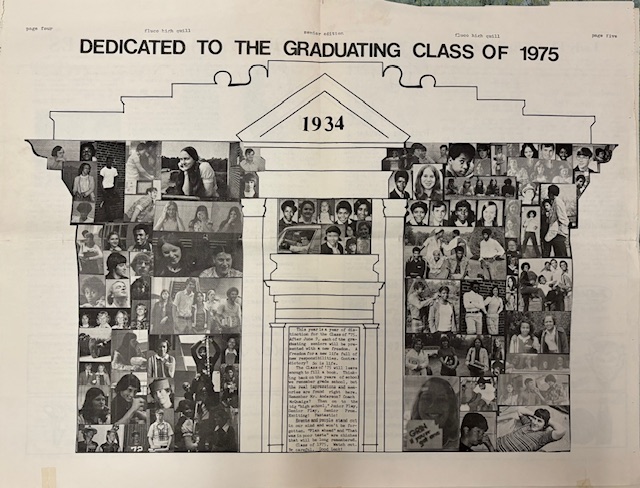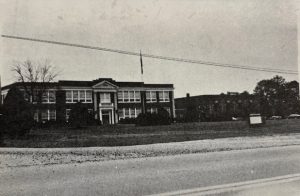There are a number of reasons that people wish that they could travel back in time. Some might have regrets or wish they had done more or less of something. On a science-fiction level, some wish that they could actually experience different eras. One aspect of Fluvanna history that has gone through several unique eras is Fluvanna County High School.
Recently, FCHS Principal Margo Bruce shared school newspapers from the years 1972 through 1975 with the Fluco Beat. One newspaper article from the May 1975 edition of the Fluco Hi Quill, as the high school newspaper was known at the time, provides insight into what life looked like in what was originally called the “Fluvanna Junior and Senior High School.” The article describes how the high school–then on Route 15–was expected to transform when a proposed “new high school” would be built.
The article, “A New High School–A Reality; No More Walks in the Rain,” notes that on March 26, 1975, Andrew, Large, and Whidden, a local Fluvanna construction company, began building a larger high school that was to be connected to Fluvanna County’s junior and senior high school (the current Abrams Academy alternative education building). The Abrams Academy building honors the Reverend Samuel Christopher Abrams, who served as the Fluvanna County supervisor for African American schools and the minister of several Baptist churches at the time.
In the 1970s, Abrams was both the middle school and high school for Fluvanna County, which is why it was named the “Junior and Senior High School.” In about 1974, the Fluvanna County School Board decided to expand the educational buildings at Abrams as there were a growing number of students and a desire to offer more class options, so the Fluvanna Senior High School was built in 1975. This new “Senior High School”is the current Fluvanna Middle School, still located next to the Abrams Academy.
The proposed new senior high school was to serve grades 9 through 12, cover 32 acres, and span 108,000 square feet. Located behind the Abrams building, it was to be connected to Abrams by covered walkways. This was to be a welcome change for students, as noted in the 1975 edition of the Fluco Hi Quill, since students previously had to walk or run through all sorts of inclement weather including wind, rain, sleet, or snow, to move from one building to another. The activity of running through the rain before the new Senior High School was built inspired the title of the 1975 high school newspaper about the upcoming new school.
The article notes that before construction, middle and high school grades 7-12 were housed in one building at Abrams. It is difficult to fathom such a large quantity of students packed into one single building. In 1975, there were only about 800 students total in the combined middle and high school populations. That number seems low compared to 2024, when FCHS enrollment alone is close to 1,500 students.
The article describes that the Fluvanna County School District estimated the new high school would cost about $3.2 million, which was $67,000 less than anticipated. Of that, between $600,000 and $750,000 came from federal and state funds, while the rest was covered by local taxes in Fluvanna County. It is interesting to know that government resources helped improve the educational environment for students. Adjusting for inflation, the $3.2 million spent in 1975 would be the equivalent of about $18.6 million in 2024.
The new senior high school built behind Abrams was to consist of three main sections: an academic wing, a vocational wing, and a gymnasium. The academic wing was to include classrooms for foreign languages, social studies, and a large library that could seat up to 110 students. It also was to contain extra rooms where students could meet for clubs and extracurricular activities.
The vocational wing was to offer practical classes like Business, Home Economics, Agriculture, Carpentry, and Masonry. It was to provide students with skills in fields that did not require a four-year college degree. Many of those programs are still provided, including Agriculture and Carpentry.
The gymnasium was to feature three basketball courts, two of which were equipped with wooden backboards, and a trampoline, which is an interesting addition to a gym, and leaves room for one to wonder. The trampoline may have been a small, indoor trampoline or perhaps something larger.
In addition to the gym, the new high school was to include athletic facilities including two tennis courts, a football stadium, baseball and softball fields, and a track. The Fluco Hi Quill article explains that the installment of a track was a relief among students, because before the new school’s construction, there was no track on site, meaning that Fluvanna was unable to host track meets and athletes could not practice running at the school. Implementing a track on-site was a significant improvement to the school’s athletic facilities, and allowed more participation and involvement in the sport from students.
The new cafeteria was to be shared between both the old Fluvanna Junior High School of Abrams and the new Fluvanna Senior High School. The cafeteria was to host three lunch periods to accommodate the combined 800 students. Presently, FCHS offers four lunch periods for the high school alone. It causes one to contemplate how much the school and the county grew from the 1970s to the present, and how it may continue to grow in the future.
Along with new facilities, the proposed high school was to introduce a variety of new class courses, including Mechanical Drawing, Building Trades, Masonry, Agricultural Business, Auto Mechanics, Consumer Clothing, and Sociology. Offering such a broad range of options probably assisted students in finding their passion and possible career path during their formative years. High school is a period when people begin to explore a variety of work fields and interests, and those who find their passion early on may leave high school ready to begin their career of choice or continue their education in a specific field.
Foreign languages including French, Spanish, and Latin were to be offered, which is interesting to reflect on today. Latin, though no longer required for a standard high school diploma, was once an important language in the academic world. Latin is not offered as a face-to-face learning class at FCHS currently, but it continues to assist in understanding the roots of many English words. It is interesting to consider whether Latin may return as a part of the school’s in-person-learning language offerings in the future.
The 1975 newspaper article also notes that two sports including tennis and a form of gymnastics were to be added to the new school’s sports repertoire. Two tennis courts were to be installed near the new school with lights that turned on in darkness for evening play, and a type of gymnastics was to be offered. The phrase “a type of gymnastics” leaves room for curiosity. Perhaps the type of gymnastics was cheerleading, or a sport that was new and specific to the time period.
One of the most intriguing aspects of reading this article from 1975 is seeing students’ excitement at the time of welcoming a new high school building, and knowing now that the Fluvanna Senior High School would not be the last high school built in Fluvanna County. In 2009, the Fluvanna County School Board approved construction of a new high school to be built on the property of Pleasant Grove. In the spring of 2009, Nielsen Contractors, a construction company based in Harrisonburg, hired BCWH Architects to begin construction on the school.
The school opened in 2012 and is now located on James Madison Parkway. The job cost about $56.8 million, but included the 277,000 square foot building as well as an auditorium, two gymnasiums, a kitchen with food service equipment, a library, offices, classroom spaces, a courtyard, science labs, music rooms and locker rooms. Additional athletic buildings including concession and field house buildings were also included in the project. Currently, FCHS serves grades 8-12, and offers more than 150 classes including Advanced Placement and Virginia Governor’s School classes. Nearly 1,500 students attend the school.
Uncovering the interesting history of Fluvanna County’s educational buildings is similar to exploring any piece of history—some parts may be surprising, some mundane, but all parts are vital to forming the foundation for what is currently experienced. High school may only be a few short years of a person’s life, but those are the formative years, where one learns through trials and tribulations the path of passion one hopes to pursue. Everyone has a future and all futures are important, so high school should direct one towards their future in the best way possible.










